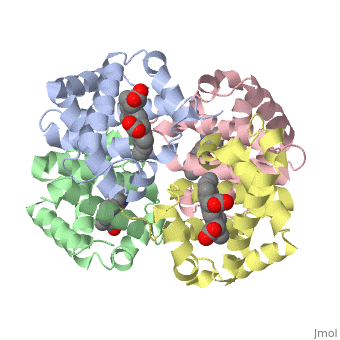Introduction to protein structure
From Proteopedia
(Difference between revisions)
| Line 1: | Line 1: | ||
== Levels of Protein Structure == | == Levels of Protein Structure == | ||
<StructureSection load='1A3N' size='350' side='right' caption='Structure of Hemoglobin (PDB entry [[1A3N]])' scene=''> | <StructureSection load='1A3N' size='350' side='right' caption='Structure of Hemoglobin (PDB entry [[1A3N]])' scene=''> | ||
| - | Proteins are condensation polymers of amino acids. The <scene name='57/575866/Primary_sequence/1'>primary structure</scene> is the amino acid sequence. The <scene name='57/575866/Secondary_sequence/1'>secondary structure</scene> is the local structure over short distances. This level of structure is stabilized by <scene name='57/575866/H_bond_a_helix/1'>hydrogen bonds</scene> along the <scene name='57/575866/Backbone/1'>backbone</scene>. These secondary structures pack together to form the overall form of the entire peptide chain, called the <scene name='57/575866/Tertiary/1'>tertiary structure</scene>. Some proteins, such as the displayed hemoglobin molecule, have more than one polypeptide chain that associate to form the functional unit of the protein; this is called <scene name='57/575866/Tertiary/2'>quaternary structure</scene>. | + | Proteins are condensation polymers of amino acids. The <scene name='57/575866/Primary_sequence/1'>primary structure</scene> is the amino acid sequence. The <scene name='57/575866/Secondary_sequence/1'>secondary structure</scene> is the local structure over short distances. This level of structure is stabilized by <scene name='57/575866/H_bond_a_helix/1'>hydrogen bonds</scene> along the <scene name='57/575866/Backbone/1'>backbone</scene>. These secondary structures <scene name='57/575866/Global_secondary_structures/1'>pack together</scene> to form the overall form of the entire peptide chain, called the <scene name='57/575866/Tertiary/1'>tertiary structure</scene>. Some proteins, such as the displayed hemoglobin molecule, have more than one polypeptide chain that associate to form the functional unit of the protein; this is called <scene name='57/575866/Tertiary/2'>quaternary structure</scene>. |
'''Questions based upon these scenes:''' | '''Questions based upon these scenes:''' | ||
What is the primary sequence shown in the first link? | What is the primary sequence shown in the first link? | ||
| Line 7: | Line 7: | ||
The ith C=O of the backbone is hydrogen bonded to which N(-H) (use i +/- # to represent the number)? | The ith C=O of the backbone is hydrogen bonded to which N(-H) (use i +/- # to represent the number)? | ||
What atom does this program NOT show? | What atom does this program NOT show? | ||
| + | What color is used to represent alpha helices? | ||
| + | How many alpha helices are present in the single peptide chain shown? | ||
| + | How many polypeptide chains make up the quaternary structure? | ||
== Ways of representing protein structure == | == Ways of representing protein structure == | ||
Revision as of 04:08, 16 January 2014
Levels of Protein Structure
| |||||||||||
Proteopedia Page Contributors and Editors (what is this?)
Ann Taylor, Joel L. Sussman, Alexander Berchansky, Eric Martz, Israel Hanukoglu, Jaime Prilusky, Nick Kenworthy

